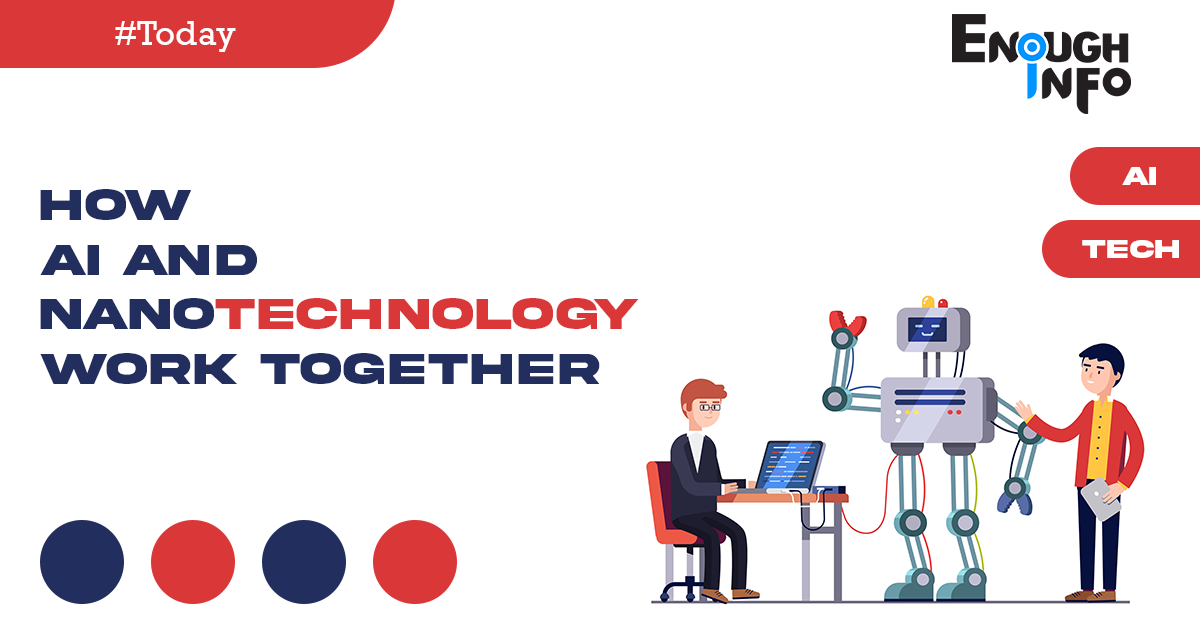How AI and Nanotechnology Work Together

How AI and Nanotechnology Work Together: AI (Artificial Intelligence) and nanotechnology are two cutting-edge fields that have the potential to revolutionize various industries, including medicine, electronics, energy, and materials science. When combined, AI and nanotechnology can work together synergistically to enhance the capabilities and applications of nanoscale materials, devices, and systems. EnoughInfo.com

Read Also: How Consensus Mechanism Works In Blockchain
FAQs & Answers on How AI and Nanotechnology Work Together
1. What is nano AI?
What exactly is nano-AI? The NCSR Demokritos-supported open platform Nano-AI aims to close the knowledge gap between the natural sciences and artificial intelligence. Domain specialists may gain from technical breakthroughs by discussing and exchanging ideas, and vice versa. How To Treat Periodic Limb Movement Disorder
2. What can nanobots do to humans?
Nanobots are task-performing robots composed of nanomaterials. Nanobots might kill cancer cells, administer drugs, and improve immunisations.Additionally, researchers employ nanobots as DNA probes, cell imaging tools, and cell-specific delivery systems.
3. How do artificial intelligence and nanotechnology connect to one another?
Nanotechnology and artificial intelligence (AI) It is possible that the fusion of artificial intelligence with nanotechnology may lead to a number of technical developments in the field of material sciences. These developments will be dependent on new computer architectures and data demonstrations. How To Stop Feeling Insecure About Your Body
Read Also: Pros and Cons of Remote Work in the Tech Industry (2023)
At the core of this synergy is the ability of AI to process, analyze, and interpret large volumes of data with speed and accuracy, while nanotechnology deals with materials and structures at the nanoscale, which is the scale of individual atoms and molecules. Nanotechnology enables the manipulation and control of materials at the nanoscale to create new materials with unique properties and functionalities that can be harnessed for a wide range of applications. How To Get Rid Of Rust (8 Good Methods)
How Can AI and Nanotechnology Work Together?
AI and nanotechnology are two cutting-edge fields of science and technology that can work together synergistically to advance various applications in fields such as medicine, electronics, energy, and materials science. Here are some ways in which AI and nanotechnology can work together: How To Be A Man
1. Nanoscale Characterization and Fabrication
Scanning electron microscopy (SEM), transmission electron microscopy (TEM), and atomic force microscopy (AFM) are just few of the nanoscale characterization methods that can benefit from artificial intelligence analysis and interpretation. Characterising nanoscale materials and structures may be performed more quickly and accurately with the help of AI algorithms due to their ability to handle massive amounts of data, extract key information, and find patterns. By optimising the qualities and performance of nanoscale materials and devices based on computer simulations and predictions, AI can also aid in their design and manufacture.
Read Also: How To Become A Technology Architect
2. Drug Discovery and Nanomedicine
Nanomedicines, which are nanoscale materials with specific medicinal uses, can be developed and discovered more quickly with the help of artificial intelligence. Artificial intelligence algorithms may examine enormous datasets, such as molecular databases, clinical data, and data on medication interactions, to find promising drug candidates and improve their performance characteristics. When combined with nanotechnology, AI can help create more precise and effective medication delivery systems with fewer adverse effects for better patient outcomes. How To Use A Jump Starter (Step by Step)
3. Nanoscale Sensing and Diagnostics
AI can be used in conjunction with nanoscale sensors and diagnostics to enable highly sensitive and specific detection of biological, chemical, and physical analytes at the nanoscale. AI algorithms can process sensor data, perform pattern recognition, and make accurate diagnoses based on the detected signals. Nanoscale sensors, such as quantum dots, nanowires, and nanocomposites, can provide real-time monitoring and diagnostics at the molecular level, and AI can enhance their sensitivity, specificity, and reliability.
4. Nanomaterials Design and Optimization
AI can facilitate the design and optimization of nanomaterials with desired properties and functionalities. AI algorithms can analyze large datasets, including materials databases, simulation data, and experimental results, to identify optimal compositions, structures, and processing parameters for nanomaterials. This can enable the development of new nanomaterials with enhanced mechanical, thermal, electrical, and chemical properties for various applications, such as electronics, energy storage, and catalysis.
Read Also: Ai: How Ai Affecting The Future Of Medical Science
5. Nanorobotics and Nanomanipulation
To enable accurate control and manipulation of nanoscale objects and structures, AI can be utilised in combination with nanorobotics and nanomanipulation methods. AI algorithms are able to analyse sensory input from nanoscale sensors and direct nanorobots to carry out difficult tasks including putting together nanoscale parts, manipulating nanoparticles to deliver drugs, and carrying out nanoscale operations. AI can make autonomous or partially autonomous nanorobotic systems, which can significantly improve the accuracy, effectiveness, and safety of operations involving nanomanipulation. How To Get Rid Of Fruit Flies (Step by Step)
6. Safety and Risk Assessment
AI algorithms can analyze data on the potential environmental, health, and safety risks of nanomaterials, such as toxicity, biocompatibility, and environmental impact. AI can also assist in the design of safer nanomaterials and processes by predicting and mitigating potential risks based on computational simulations and modeling.
Read Also: Director Of Engineering Job Description
Conclusion
Nanotechnology frequently employs complex systems that are not necessarily appropriate for the many components of AI. However, there are several expanding fields where nanotechnology and AI are merging. In addition to combining the two technologies, integrated research in nanotechnology and AI may also advance studies in each field, potentially resulting in a wide range of new communication and insight-gathering capabilities.
Recommended;
How Consensus Mechanism Works In Blockchain
How To Make Money With Blockchain Technology
AI-generated art and NFTs Technology (All You Need to Know)




